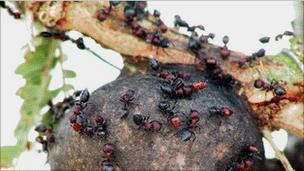Ants work with acacia trees to prevent elephant damage
- Published

Symbiotic ants live on and benefit from this acacia tree
A species of acacia tree found in Eastern Africa seems to be protected from elephant damage - by the ants that live on it.
Researchers from the Universities of Wyoming and Florida, in the US, carried out a series of studies in Laikipia District in Central Kenya, and Tsavo National Park, also in Kenya.
Tree cover was decreasing while elephant numbers were increasing. Tree cover stayed the same where elephants were excluded using a high electric fence that other animals can cross.
Elephants are very effective at stripping trees' bark and destroying them while feeding. "The number of elephants in the central highlands of Kenya has become high enough in recent years that we see severely elephant-damaged trees all over the place these days," said study author Todd Palmer.
The researchers were intrigued though when they noticed that tree cover had only decreased in areas with sandy soil - not those with clay soil.
Professor Palmer, together with Jake Goheen, who are publishing their results in the journal Current Biology, noticed that on the clay soil there seemed to be only one kind of tree - an acacia called Acacia drepanolobium. In other areas with sandy soil, there was a much wider range of tree types.

An elephant browsing acacia forest in central Kenya
What is special about this type of tree is that it has a symbiotic relationship with ants. The plant provides shelter and food for the ants, and it now seems that the ants protect the plant from elephants.
In order to find out exactly what was putting the elephants off these trees, Professors Palmer and Goheen first tried stripping ants from the ant plants.
Elephants then became interested in eating the trees, but the ants came back - the more ants there were, the less elephants wanted to eat the trees.
After this, they gave semi-wild elephants in a rehabilitation centre in Tsavo National Park four types of branches.
They tried the ant plant, both with and without ants, and another acacia plant, also with and without ants. "The elephants wouldn't even touch the branches with ants on - they could smell the ants and knew it would be painful to eat them", says Professor Goheen.
The elephants seem to be wary of getting bitten on the soft undersides of their trunks.
Other large herbivores, especially giraffes, will eat the plants, probably because they are not as bothered by the ants. Nigel Raine, another ecologist from Royal Holloway, University of London, also studies these ant plants, and says that giraffes will go ahead and eat the leaves of the plants, although ants will then swarm onto their face and mouth and try to bite them.
"Whenever you create a disturbance in the tree canopy, the ants come and investigate. As an ecologist, you end up with a lot of bites and stings," says Dr Raine.
Plants that are symbiotic with ants can be found in other parts of the world, especially Central and South America, where there are no elephants, but large herbivores lived before they became extinct.
In fable elephants are afraid of mice, but in reality they seem to be more afraid of insects. Previous studies have found that elephants are not only afraid of ants but also will run away from areas with bees, as soon as they hear them buzzing.